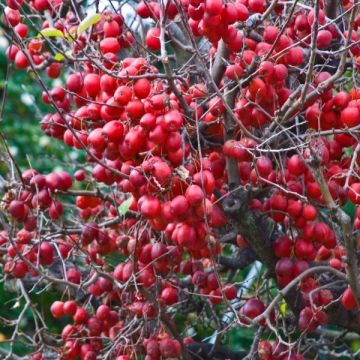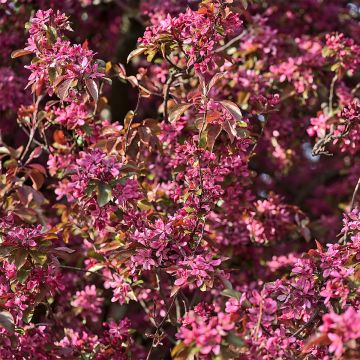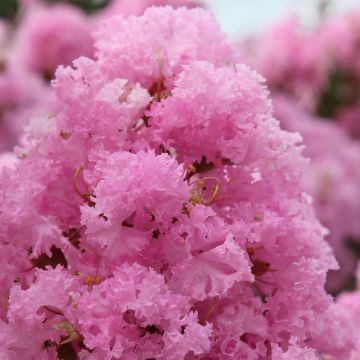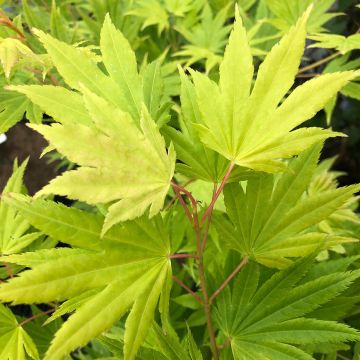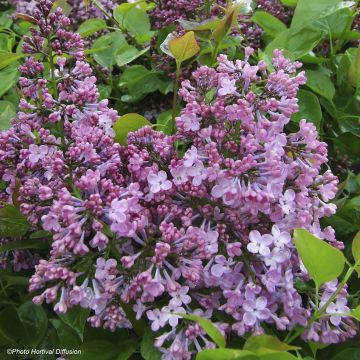

Malus John Downie - Crab Apple
Malus John Downie - Crab Apple
Malus John Downie
Apple Tree, Crab Apple
This item cannot be shipped to the selected country
Delivery charge from €5.90
Oversize package delivery charge from €6.90
More information
Schedule delivery date,
and select date in basket
This plant carries a 24 months recovery warranty
More information
We guarantee the quality of our plants for a full growing cycle, and will replace at our expense any plant that fails to recover under normal climatic and planting conditions.
From €5.90 for pickup delivery and €6.90 for home delivery
Express home delivery from €8.90.
Oversize package: home delivery by special carrier from €6.90 per order..
Express home delivery from €8.90.
Does this plant fit my garden?
Set up your Plantfit profile →
Description
The Malus John Downie is a very old variety of ornamental apple tree always appreciated for its abundant and colourful fruiting. This small tree attracts attention in spring with its abundant white-pink flower clusters, and again in late summer with its superb small orange apples that turn red in the sun. Its moderate growth is suitable for gardens of all sizes. When space allows, ornamental apple trees planted in a large hedge create a fairly magical scene in spring and autumn.
Ornamental apple trees come from various botanical species of the genus Malus belonging to the Rosaceae family. Hardy, accommodating, and easy to grow, flowering apple trees can tolerate ordinary soil but prefer deep, loose, and fresh loamy soil and sunny exposures. Once established, they can be perfectly forgotten while maintaining their generous nature. Numerous cultivars have emerged in Europe and the United States, becoming increasingly attractive and disease-resistant. 'John Downie', on the other hand, was obtained in 1875 by Edward Holmes from Lichfield, England.
A large bush or small tree, the ornamental apple tree 'John Downie' has an upright habit in its young age. Over time, the crown becomes rounded, resembling the silhouette of a broad pyramid. Its average dimensions at maturity are around 4m (13 ft 1 in) in height and 3m (9 ft 10 in) in width. It maintains a harmonious shape without the need for pruning and develops fine wood.
Flowering takes place in April-May, depending on the climate, on bare branches, in the form of numerous white buds. They open into single flowers, measuring 3.5 to 4 cm (1.4 to 1.6 in) in diameter, with a barely pinkish-white colour. These flowers, gathered in small clusters, are followed by young leaves. After pollination, a multitude of small oval-shaped apples, often clustered together, form, measuring 3 to 4 cm (1.2 to 1.6 in) in length. They turn from yellow to orange at maturity in September, with the sun-exposed side becoming red. Highly appreciated by birds, these fruits remain on the tree until late autumn, in November. The deciduous foliage consists of ovate, alternate, and toothed leaves.
The Malus 'John Downie', like many flowering apple trees, is a good pollinator for early-flowering fruit trees. Its abundant flowering, although possibly less long-lasting than that of a flowering cherry tree, is extended by the beauty of its fruits in late summer. The habit adds to the charm of this charming plant where many birds venture. It will find its place in a medium to large-sized garden, in a free hedge, accompanied, for example, by large shrub or climbing roses trained as shrubs, evergreen Viburnum, and lilacs.
Report an error about the product description
Malus John Downie - Crab Apple in pictures


Plant habit
Flowering
Foliage
Botanical data
Malus
John Downie
Rosaceae
Apple Tree, Crab Apple
Cultivar or hybrid
Other Malus - Crabapple
Planting and care
Easy to grow in ordinary but deep soil, the Malus 'John Downie' requires a bright exposure. Ornamental Malus are generally very accommodating, but they like fertile, fresh and deep soils. After careful planting and installation accompanied by regular watering during the first two years, they manage on their own. Install it in the sun or in partial shade in cool, fairly rich but well-drained soil, giving it enough space to spread. Dig a large planting hole. If the soil is poor, add compost to the planting soil and apply fertilizer or compost to its base every spring. To prevent diseases, treat with Bordeaux mixture in spring.
Planting period
Intended location
Care
This item has not been reviewed yet - be the first to leave a review about it.
Trees for small gardens
Haven't found what you were looking for?
Hardiness is the lowest winter temperature a plant can endure without suffering serious damage or even dying. However, hardiness is affected by location (a sheltered area, such as a patio), protection (winter cover) and soil type (hardiness is improved by well-drained soil).

Photo Sharing Terms & Conditions
In order to encourage gardeners to interact and share their experiences, Promesse de fleurs offers various media enabling content to be uploaded onto its Site - in particular via the ‘Photo sharing’ module.
The User agrees to refrain from:
- Posting any content that is illegal, prejudicial, insulting, racist, inciteful to hatred, revisionist, contrary to public decency, that infringes on privacy or on the privacy rights of third parties, in particular the publicity rights of persons and goods, intellectual property rights, or the right to privacy.
- Submitting content on behalf of a third party;
- Impersonate the identity of a third party and/or publish any personal information about a third party;
In general, the User undertakes to refrain from any unethical behaviour.
All Content (in particular text, comments, files, images, photos, videos, creative works, etc.), which may be subject to property or intellectual property rights, image or other private rights, shall remain the property of the User, subject to the limited rights granted by the terms of the licence granted by Promesse de fleurs as stated below. Users are at liberty to publish or not to publish such Content on the Site, notably via the ‘Photo Sharing’ facility, and accept that this Content shall be made public and freely accessible, notably on the Internet.
Users further acknowledge, undertake to have ,and guarantee that they hold all necessary rights and permissions to publish such material on the Site, in particular with regard to the legislation in force pertaining to any privacy, property, intellectual property, image, or contractual rights, or rights of any other nature. By publishing such Content on the Site, Users acknowledge accepting full liability as publishers of the Content within the meaning of the law, and grant Promesse de fleurs, free of charge, an inclusive, worldwide licence for the said Content for the entire duration of its publication, including all reproduction, representation, up/downloading, displaying, performing, transmission, and storage rights.
Users also grant permission for their name to be linked to the Content and accept that this link may not always be made available.
By engaging in posting material, Users consent to their Content becoming automatically accessible on the Internet, in particular on other sites and/or blogs and/or web pages of the Promesse de fleurs site, including in particular social pages and the Promesse de fleurs catalogue.
Users may secure the removal of entrusted content free of charge by issuing a simple request via our contact form.
The flowering period indicated on our website applies to countries and regions located in USDA zone 8 (France, the United Kingdom, Ireland, the Netherlands, etc.)
It will vary according to where you live:
- In zones 9 to 10 (Italy, Spain, Greece, etc.), flowering will occur about 2 to 4 weeks earlier.
- In zones 6 to 7 (Germany, Poland, Slovenia, and lower mountainous regions), flowering will be delayed by 2 to 3 weeks.
- In zone 5 (Central Europe, Scandinavia), blooming will be delayed by 3 to 5 weeks.
In temperate climates, pruning of spring-flowering shrubs (forsythia, spireas, etc.) should be done just after flowering.
Pruning of summer-flowering shrubs (Indian Lilac, Perovskia, etc.) can be done in winter or spring.
In cold regions as well as with frost-sensitive plants, avoid pruning too early when severe frosts may still occur.
The planting period indicated on our website applies to countries and regions located in USDA zone 8 (France, United Kingdom, Ireland, Netherlands).
It will vary according to where you live:
- In Mediterranean zones (Marseille, Madrid, Milan, etc.), autumn and winter are the best planting periods.
- In continental zones (Strasbourg, Munich, Vienna, etc.), delay planting by 2 to 3 weeks in spring and bring it forward by 2 to 4 weeks in autumn.
- In mountainous regions (the Alps, Pyrenees, Carpathians, etc.), it is best to plant in late spring (May-June) or late summer (August-September).
The harvesting period indicated on our website applies to countries and regions in USDA zone 8 (France, England, Ireland, the Netherlands).
In colder areas (Scandinavia, Poland, Austria...) fruit and vegetable harvests are likely to be delayed by 3-4 weeks.
In warmer areas (Italy, Spain, Greece, etc.), harvesting will probably take place earlier, depending on weather conditions.
The sowing periods indicated on our website apply to countries and regions within USDA Zone 8 (France, UK, Ireland, Netherlands).
In colder areas (Scandinavia, Poland, Austria...), delay any outdoor sowing by 3-4 weeks, or sow under glass.
In warmer climes (Italy, Spain, Greece, etc.), bring outdoor sowing forward by a few weeks.




































